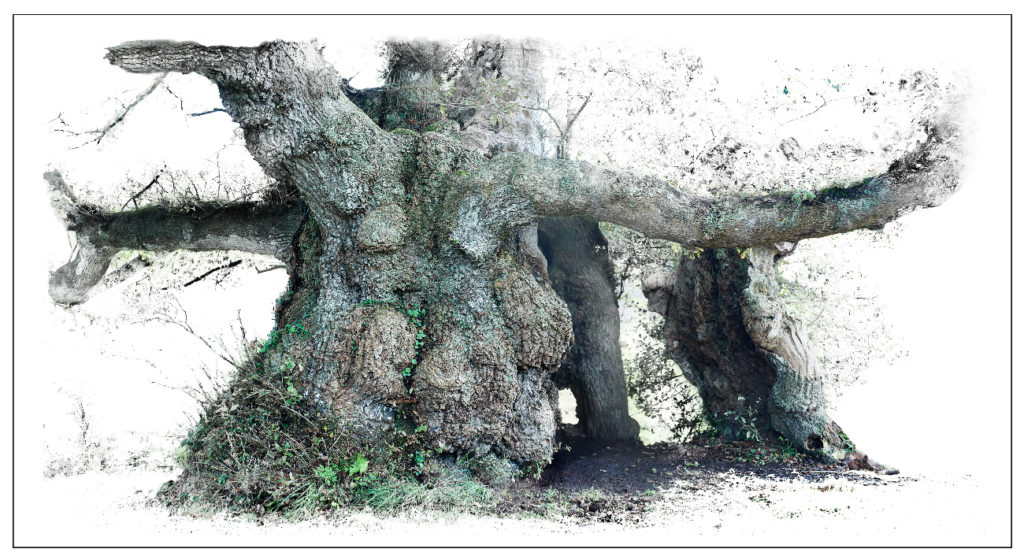
Immortal Oak, Brittany
CedricBregnard. ch – Participatory project: racinesduciel
It’s the tree of fairy tales and fantasy novels, and the stuff of mythology, associated with the dryads of the Greeks, or with a door that closes one annual cycle and opens onto the next for the Hindus. It is also the temple of the Celts, around which the Druids gather and to which they all refer.
At first, the oak fascinates our imagination, before we marvel at more scientific discoveries linked to its Latin name of Celtic origin, quercus, which means tree par excellence.
As a child, we tell ourselves that we’ve entered one of its loopholes, that we’ve entered another world, that we’ve arrived elsewhere, where everything is different, and where we’ll be able to reinvent ourselves in the process. We have an intuition of the gateway it represented for ancient civilizations. When you discover as an adult that oak in English is called Oak, which derives from a Sanskrit word meaning door, you smile at this correspondence.
Un peu plus tard, après les premières blessures portées par la vie, on pourra reprendre courage face à un vieux chêne. Parce qu’il ne pousse ni droit ni au garde-à-vous. Parce que ses branches sont irrégulières, tordues, tourmentées, et qu’il s’en dégage pourtant une impression de sagesse et de puissance. Le chêne traverse les épreuves du temps sans plier, il reste solidement enraciné, rendu plus fort par ce qui ne l’a pas tué.
He’s a king who plans his breaks. It equips branches that could be lost in stormy winds or heavy snow with a bulge, a kind of cushion that will help healing should they fall.
We take our cue from him. We imagine ourselves as warriors returning from the battlefield, amputees but alive, ready to fight again, or broken-hearted, soul-scratched, but ready to love again, to give our trust, in an enthusiastic but devoid of candor. Starting again, persevering, means taking risks, going ahead anyway, preparing for it.
Dans l’astrologie celtique, car les Celtes regardaient les forêts plutôt que les étoiles, le chêne est l’arbre du 21 mars. Premier jour de printemps. On recommence un cycle. On ouvre la porte sur la vie qui reprend. Mars, c’est aussi le dieu de la guerre, celui de notre guerrier à feuilles lobées, et d’une planète qui porte son nom.
New concordance. Correlations between intuition and deduction, superstition and proven fact, abound when it comes to oak trees. Are today’s scientists simply proving what the ancients knew otherwise?
Twenty years ago, Swiss forestry engineer Ernst Zürcher succeeded in demonstrating that trees pulsate, and that the internal movements of sap are linked to the cosmos. Like water, they react to lunar tides. Taking their research a step further, the scientists discovered that trees react not only to the moon, but also to the planet traditionally assigned to them. Oak buds pulse according to whether the moon is aligned with or in opposition to Mars.
Rien de plus fascinant que les hasards qui n’en sont pas.
Just one more. Brittany is home to a famous hundred-year-old oak, the Hulo rag tree. Even today, according to a practice that dates back to pagan cults, people still attach pieces of clothing to it, in the hope of obtaining a cure for a skin disease. In this way, the disease can leave the patient’s body and be transferred to the tree. Superstition has its own explanation, but we don’t know whether it precedes or follows superstition. Due to its high tannin content, oak bark is astringent, making it an excellent remedy for eczema and other skin diseases.
Finally, the oak traditionally used to clarify a house wine is still used today in barrels to house and age certain vintages, imparting its woody aromas to the grapes.
The perfect way to continue dreaming of this essence while enjoying a grand cru.

